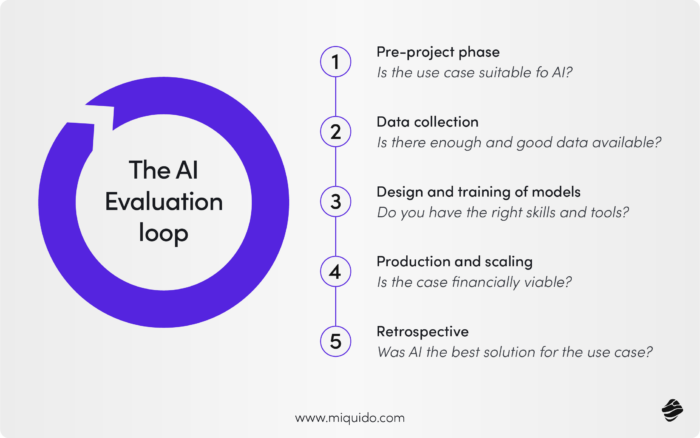

AI Evaluation Definition
AI Evaluation
AI evaluation refers to the process of assessing the performance, accuracy, and reliability of AI models designed to generate content, such as text, images, music, or videos. Model evaluation metrics are crucial for assessing AI models to ensure they meet the desired objectives. AI evaluation is a critical aspect of machine learning to ensure models perform as expected. Large language models, like GPT, Gemini, or Mistral, are evaluated to ensure that they produce coherent, high-quality outputs that meet the desired objectives without creating harmful or unethical content. Evaluating these systems involves using various AI evaluation metrics tailored to the unique challenges of generative models, such as creativity, factual accuracy, and ethical alignment.
AI Model Evaluation in Generative AI
Generative AI has the potential to produce content autonomously, which opens up a wide range of applications but also presents risks. AI evaluation is essential to ensure that these systems create valuable, safe, and unbiased outputs. Without careful evaluation, generative AI might generate misinformation, biased or offensive material, or content that infringes on intellectual property. As these models are deployed in fields like marketing, entertainment, and even education, evaluating the model’s performance is crucial for controlling the quality and ethics of AI-generated content.
The evaluation of generative AI models is more complex than in traditional AI systems because their output is often subjective and open-ended. While a classification AI model can be evaluated with straightforward metrics like accuracy, generative AI models must be assessed on factors like originality, coherence, relevance, and creativity. Therefore, AI model evaluation for generative AI often involves both automated metrics and human judgment to determine the quality of the content generated.

Evaluating model predictions is crucial for ensuring the accuracy and reliability of generative AI outputs.
Key factors in AI evaluation
- Creativity and Originality: A key factor in AI evaluation for generative models is assessing how creative or original the outputs are. For example, when generating images, it’s important to evaluate whether the AI produces unique designs or simply mimics existing patterns. For text models like GPT, the model should create human-like, yet diverse and inventive, language structures by comparing the generated outputs to actual values to assess originality.
- Coherence and Relevance: Generative AI systems must produce outputs that are coherent and contextually relevant. For example, in natural language generation, the AI should maintain logical consistency throughout the text, and in image generation, the output should match the user’s prompt. Evaluating coherence involves checking whether the output stays on topic and avoids contradictions or errors. The confusion matrix plays a crucial role in evaluating classification performance by comparing actual and predicted outputs across multiple classes.
- Factual Accuracy: In some applications, especially those involving text generation, ensuring factual accuracy is vital. A common problem with large language models is their tendency to “hallucinate” information, where they produce plausible but incorrect facts. Mean absolute error is a key AI evaluation metric when the AI is generating news articles, educational content, or other information where accuracy is critical.
- Bias and Ethical Considerations: Given the wide-ranging impact generative AI can have on society, AI evaluation also involves assessing the ethical implications of the generated content. It is important to evaluate whether the AI generates AI bias or harmful content, particularly regarding race, gender, or sensitive cultural issues. Ethical guardrails are increasingly important in AI model evaluation for preventing outputs that perpetuate harmful stereotypes or spread disinformation.
Model Evaluation Metrics for Generative AI
Several AI evaluation metrics are commonly used to assess the performance of generative AI models:
- Perplexity: In text generation models, perplexity is a metric that measures how well a language model predicts the next word in a sequence. Lower perplexity indicates that the model is better at predicting the flow of natural language, meaning it produces more coherent and realistic text. Additionally, absolute error is another metric for evaluating prediction accuracy, particularly in regression models.
- BLEU Score (Bilingual Evaluation Understudy): For natural language generation, the BLEU score is a common metric used to compare the AI-generated text with a reference text, evaluating how well the output matches human-generated content. While useful, it’s important to note that BLEU scores may not fully capture creativity or nuanced human writing. Absolute percentage error also plays a role in evaluating the accuracy of predictive models by assessing the difference between actual and predicted values as a percentage.
- Human Evaluation: Given the subjective nature of generative AI outputs, human evaluation plays a significant role in AI model evaluation. In tasks like text generation, human reviewers may assess fluency, coherence, and relevance, while in image or music generation, they may evaluate aesthetic quality, creativity, and user satisfaction. Data points are significant in various evaluation methods, providing essential metrics for assessing model performance.
- Toxicity and Bias Detection: Since generative AI models can inadvertently generate harmful or biased content, specialized tools are used to detect and evaluate these issues. These tools scan outputs for potentially offensive language, misinformation, or bias, and ensure that the AI complies with ethical standards. Predicted and actual values are crucial in assessing model accuracy, helping to identify discrepancies and improve performance.
Challenges in Evaluating Generative AI
AI evaluation for generative models presents several unique challenges:
- Subjectivity of Outputs: One of the most difficult aspects of AI model evaluation in generative AI is the subjective nature of the outputs. Continuous evaluation is crucial in the machine learning lifecycle to monitor performance with new incoming data. While some metrics can quantify aspects of performance, such as accuracy or fluency, others, like creativity and relevance, often require human judgment.
- Ethical and Social Impacts: Generative AI models, particularly those used for text and image generation, can have wide-ranging social impacts. Evaluating the ethical implications, including potential biases and harmful outputs, is a major concern that requires ongoing refinement of both the AI and its evaluation metrics. Model monitoring plays a critical role in overseeing the performance of these models, ensuring they continue to perform well and ethically with new data.
- Overfitting to Specific Metrics: A danger in evaluation is overfitting models to perform well on specific metrics, like BLEU or FID, at the cost of general performance or creativity. Generative AI models might optimize for a high score in one area, while still producing subpar or uninspired content overall.
Importance of Evaluation in Generative AI Applications for Model’s Performance
In real-world applications, AI evaluation metrics play a crucial role in ensuring that generative AI systems deliver high-quality content that meets user expectations. For instance:
- Content Creation: In media and marketing, generative AI is increasingly used to create text, images, and videos. Evaluating and comparing multiple models ensures that the generated content is engaging, relevant, and free from bias.
- Chatbots and Virtual Assistants: For generative AI used in customer service or personal assistants, coherence, relevance, and tone are key. Evaluation ensures that AI chatbots provide accurate and helpful responses that maintain a conversational flow. Different threshold values are used to analyze the model’s performance in distinguishing between various classes.
- Entertainment: Generative AI is also employed in creating music, art, and even scripts for movies and TV shows. Evaluation here focuses on creativity, uniqueness, and the overall appeal of the generated content to human audiences.
In summary, AI evaluation for generative models is a complex but crucial process to ensure these systems produce high-quality, reliable, and ethical outputs. By applying the right evaluation metrics, including both automated assessments and human feedback, developers can create generative AI systems that are not only technically advanced but also responsible and valuable to users. AI model evaluation in generative AI spans a wide range of factors, from creativity and coherence to bias and ethics, making it an ongoing challenge and priority as these technologies continue to evolve.
Ready to discover more terms?





